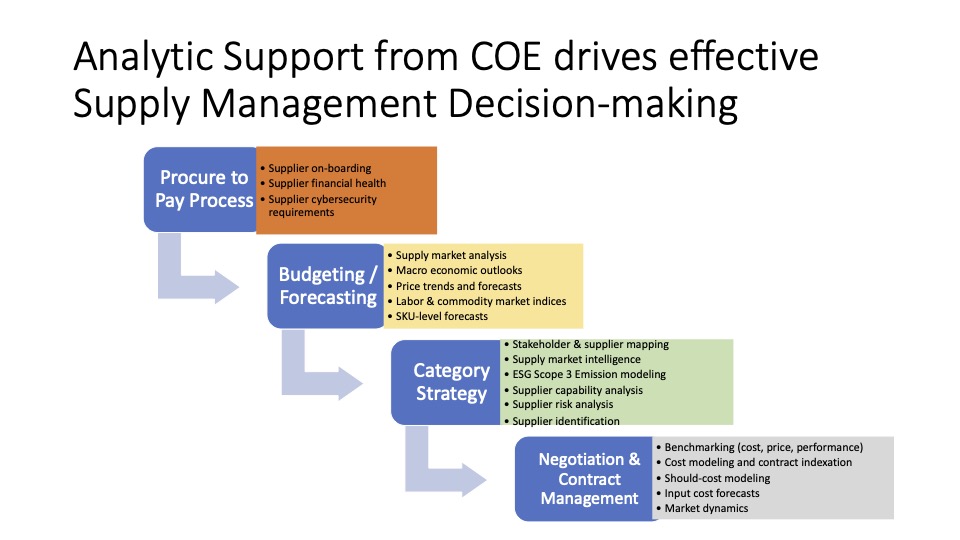Performance Measurements and Metrics: What Should the Professional Supply Chain Manager Know about Six Sigma?
Performance Measurements and Metrics
Brainstorming
Balanced Scorecard
Four Perspectives Approach
When six sigma is used as a metric, it means that defects per million opportunities (DPMO) must be below 3.4. This number can be derived by assuming that, in addition to random variability, process averages drift by 1.5 standard deviations, regardless of how well they are controlled. These circumstances result in a one-sided integration under the normal curve beyond 4.5 standard deviations, which equals an area that approximates 3.4/1,000,000 (3).
However, six sigma metrics can go far beyond 3.4 DPMO. Metrics can also include things such as the duration and/or cost of value added steps versus non-value added steps of developing and/or delivering one unit. This metric can also be known as the Cost of Poor Quality (COPQ) (4). The true metrics behind six sigma are the ones that actually allow you to achieve the 3.4 DPMO goal. These metrics are an integral part of DMAIC, the five phases of six sigma. In the measurement phase, the defined metrics are measured and tracked (3). Typically these measurements are plotted on a control chart, along with a target for the project and a world-class benchmark (5).
Brainstorming
The methods that can be used to develop these evaluation tools can vary greatly. One of the more common methods used to develop metrics is to understand the problem statement and then brainstorm potential metrics. During the brainstorming process, it should always be kept in mind that metrics should be based on what needs to be measured in order to improve the process and that they should always add value in understanding a process. They should not be developed simply because they can be tracked with current measurement systems. Once a list of potential metrics has been developed, each one is then evaluated on how effective it would be at helping to achieve better performance. Once the most effective metrics have been selected, the list is then reviewed with senior management to ensure that they are compatible with the overall strategy of the business (6).
top
A popular method for developing metrics is known as the balanced scorecard approach. This approach ensures that the project meets both customer needs and business needs. The balanced scorecard approach takes into account both financial and non-financial metrics. The approach also includes lagging and leading measures in four areas: financial, customer, internal processes, and employee learning and growth. Lagging measures are defined as those measures that are made at the end of the project, while leading measures are defined as those measures that are made to help achieve the objectives and are measured upstream of the event. Typically the metrics developed from this approach come about through the brainstorming method described earlier. The downside to this method is that it tends to have little success in creating sound metrics that have a balance between leading and lagging measures (6).
top
h2. Four Perspectives Approach
A variation of the balanced score card approach is known as the four perspectives approach. This approach directs team members to focus on four questions:
- Financial Perspective: “What financial objectives must we accomplish to ensure the success of our project?”
- Customer Perspective: “By working on this project, what customer objectives will be met?”
- Internal Perspective: “To achieve our customer objectives which process will have to be worked on?”
- Learning Perspective: “To achieve our project goals, how must our team learn and innovate?”
Once the team has utilized these questions to direct their brainstorming, the objectives that the project must meet should become apparent. These objectives should then be mapped in a strategy map that covers all of the projects and perspectives of the organization (6).
Once this strategy map has been developed, the team can then finally brainstorm metrics for each objective while maintaining a balance between lagging and leading metrics. This approach assures that the team selects metrics that are aligned with the strategy (6). Generally, metrics should meet the following criteria (6):
- Involve leadership: Since management sets the strategy for the company, they must ensure that the metrics being used support the overall business.
- Represent visually: Metrics should be displayed in an easily accessible place, so the employees can track progress and understand their impact upon the process.
- Fast responding: The measurement systems used to generate the metrics should be able to work quickly and efficiently to provide the data. These characteristics will allow problems to be rapidly identified and resolved as soon as possible.
- Must be simple: The data provided must be easy to use. “You want direct information to take direct action.”
- Metrics only drive important activities: Metrics should only be linked to important factors. Companies should not use metrics to track frivolous or extraneous activities.
- Limited number of metrics: Metrics should be limited to a maximum of ten. Drawing on more than ten metrics tends to become overwhelming and cumbersome.
- Corrective action required: The team should respond immediately to issues identified by metrics and correct the problems. Once the process has achieved the desired goals, momentum should be kept going by moving on to the next project and setting new metrics.
top
- Categories:


